 Even when you’re no longer a student, memory affords the distinct remembrance of the back to school rush. The Bookisshh difference is that my reads are not required and I’m guessing offer enjoyment.
Even when you’re no longer a student, memory affords the distinct remembrance of the back to school rush. The Bookisshh difference is that my reads are not required and I’m guessing offer enjoyment.
** As a note, I’m back to the rating system which is based on 5 pens (half pens are considered to be missing caps) Enjoy!
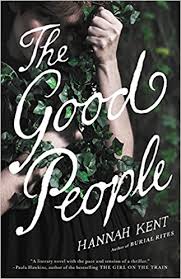
Adult Literary Fiction:
The Good People by Hannah Kent (4 pens)
A quietly dark and twisted tale set in rural Ireland during the mid 1800s. Each chapter aptly titled after a tree, shrub, flower or herb carrying medicinal properties used in folk remedy and is employed to hex or fix characters in the narrative.
Death plagues the villagers and it all coincides with the appearance of a recently arrived changeling child thrust upon his grandparents only weeks after his mother’s unexplained illness and death.
It’s agreed upon that this changeling must be exorcised and returned to the fairies who live nearby. Engaged is the handy woman and keener of sorts to banish the forces plaguing the poor rural Irish community. As gossip spreads about so too does death among the villagers including children.
Meanwhile, Catholicism is making its way among the converted heathens except for the skeptical few continuing to practice folkloric beliefs. The handy woman, a scapegoat and martyr is punished for sinful devotion to the supernatural forces. In all of her scruff and scrappiness handy woman’s intentions are pure–to heal and sustain her people in spite of her archaic practices and a witchy appearance.
Taken to task are folklore and religion within in the Irish courts and legal decision is well rendered in this historic context. Narrated in buttery brogue, about 50ish pages too long but entertaining still, “The Good People” compelled me to spend time walking in the woods and wonder over good and evil flora and fauna. Out this September when green fades, seeds rattle and branches become bare.
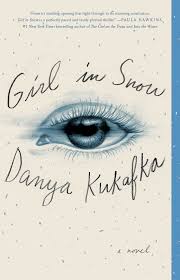
Adult or Mature YA Suspense:
Girl in Snow by Danya Kukafka (3 pens)
Not a thrills and chills sort of thriller, but more of a commentary on the obsessive nature of perception when not tempered by truth or real experience. Complex and stunning prose holds together quirky characters coping with conflicts ranging from coming of age, homosexuality, dysfunction, mistake making and misguided conceptions of love.
The first two-thirds of the book are reasonably paced and structured into alternating points of view belonging to various suspects who might be implicated in murdering young Lucinda leaving her to remain frozen in the snow on the playground. The book sways toward establishing a primary narrator, Jade, who like the others peopling this story is loosely developed. Jade, single-parented is a jealous sentinel watching Lucinda and a stalker classmate go about their lives. Jade sees Lucinda capitalize everything she wants–boys, babysitting jobs and social acceptance. She’s glad Lucinda is gone. Cameron stalks and skulks about homing his keen powers of observation to the point of compulsion. He spends hours outside Lucinda’s bedroom studying and recording her every move. No one should appreciate Lucinda more than him.
Who killed her because she is dead? Suspects abound but nobody’s tie in is a shoe in. The strength of writing these characters is two fold–their quirkiness and the deep immersion Kakafka offers on their point of view. The prose is rich and biting here.
Kukafka leaves readers wading in shallow water searching for motive and the distractions she offers as red herring deflate dramatic intensity.
I’d knock this book off the shelf with “The Lovely Bones” by Alice Sebold, which while difficult to read, well accomplishes suspense genre elements which should be guaranteed to readers as “Girl In Snow” does not deliver. The cover is pretty though…
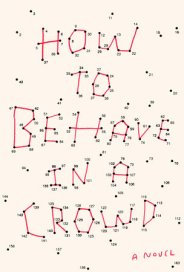 Adult Literary Fiction or Mature YA:
Adult Literary Fiction or Mature YA:
How to Behave In A Crowd by Camille Bordas (3 pens)
Bordas crafts an insightful view into adolescent boy, Isidore Mazal’s French family and life. Set in France, during the late 90s before high tech enters the narrative, readers become voyeurs to Isidore Mazal’s home world within which siblings range significantly in age and PhD dissertation content. Among his family of over achieving intellectuals, Isidore struggles with his identity and suppressed emotions due to the recent loss of his father. Father Mazal, normally absent is now permanently so and no one is talking about it. An adolescent boy who is filled with questions becomes more full and all who love him are consumed with their own missions. To the world he turns and as Isidore does he begins to come of age and runs away, returns, runs again, has intimate relationships and gains insight.
“Dory,” nicknamed by his siblings, is remarkably sophisticated in his capacity to connect and communicate with his family and other acquaintances outside his home. Perhaps unrealistically so given his age. Though ideal, the dialogue between siblings, friends and random people Dory encounters is captivating and rewards readers with stunning insights and laughs regarding human nature.
Within this population of savant and geniuses Bordas has a WONDERFUL sense of humor captured in the articulate and painfully true observations and conversations issued forth from Dory’s older sibling, Simone. Simone is a character who deserves a novel of her own perhaps with this title.
At times pedantic and mildly repetitive peppered with wonderful local, colorful characters the pace was sluggish and life altering decision making of characters is taken to excess. The conclusion felt foggy leaving Dory with a subtle understanding of where he comes from and what gets in the way. “How To Behave In A Crowd” might be the “Harold and Maud” of its time without the odd age driven physical relationships but at least Harold came away from his story learning something.
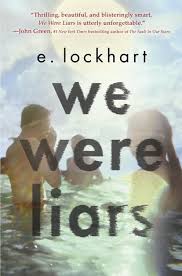
YA Fiction
We were liars by e. lockhart (4 Pens)
Pretty good tale for the YA readers. A cast of cousins on a privately owned New England island with a family compound of 4 homes, a fire is lit and YA readers witness a young woman’s rediscovery of what happens because when she returns so too does her memory.
“We were liars” is well-paced maintaining a quietly simmering conflict. Told in first person point of view by an unreliable narrator there are small gaps in plot development as the storyteller reaches for honesty in a context of reader persecution. Readers are put in a precarious position of judge and jury blinded by narrow experience and stereotypes.
Narrator, Cadence Sinclair has a, “Don’t hate me for being rich and beautiful even though I do–” quality as she looks closely back at her summers on the island with her first cousins, aunts and grandfather. Plagued by white privilege going back to the Mayflower, Cadence smells the rot in the cloth her brood is cut from. As Cadence abandons her mind numbing medications, casts aside roles and costumes demanded by her family story, she is blinded by what illuminates the truth.
‘We were liars” offers YA readers an honest look at actions and consequences teens can take when they are struggling for authenticity while relegated to a hollow life valuing surface fashion. E. Lockhart ties up her tale neatly and stretches the message that mistakes are forgiven a bit far, but renders in sharp reminder that families are where we start, finish and therefore should always remain a place of love. Lockhart and Cadence leave readers with the understanding that every generation moves the one prior forward and though difficult is necessary.
Book Box Subscription Review! Every once in a while I buy one of these to see how reading experiences can be further cultivated, and book box subscriptions are one way to get there. This issue of Bookissh features:
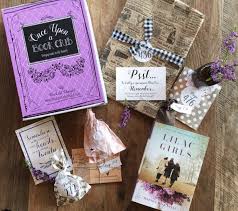
The name of this company is, “Once Upon A Book Club Box” and they offer a variety of subscription modes. You can buy a quantity of 1 if you buy an old box, but this pushes you out of the reader club that reads and discusses in various social media platforms like Facebook and Instagram. Alternately, you can buy a monthly, quarterly or yearly subscription. I did a monthly.
How does it work? You get a box that contains a book and between 5-6 wrapped gifts and discussion questions. Next, you read the book and encounter a pre-inserted post-it note that tells you to open your gift which relates to the story in some capacity. It’s kind of like a reader is rewarded for reading. Finally you get to join a discussion on-line or live stream with chit-chats regarding the discussion questions and the gifty stuff.
The upshot–some of the books are ok (see above) and maybe one of the gifts is something you might use. Plus, the box is nice! The downside–most of the gifts are clutter ripe for landfill. Further, the two books I got qualify as Harlequin-ish and not a genre this reader looks to. Lastly, their terms are tricky and should you wish to unsubscribe BEWARE of your dates which are highly interpretable in the club’s favor. In sum, beware of expressing dissatisfaction in any public forum.. The club members are HIGHLY DEVOTED to the product and will lash out at you if you are viewed expressing your verified opinion in any public forum. When I thought I unsubscribed in time, it wasn’t processed for 48 hours, so it didn’t matter that I followed the guideline. The takeaway–I suffered two boxes and mildly escaped some sort of frustrated women’s cult!
